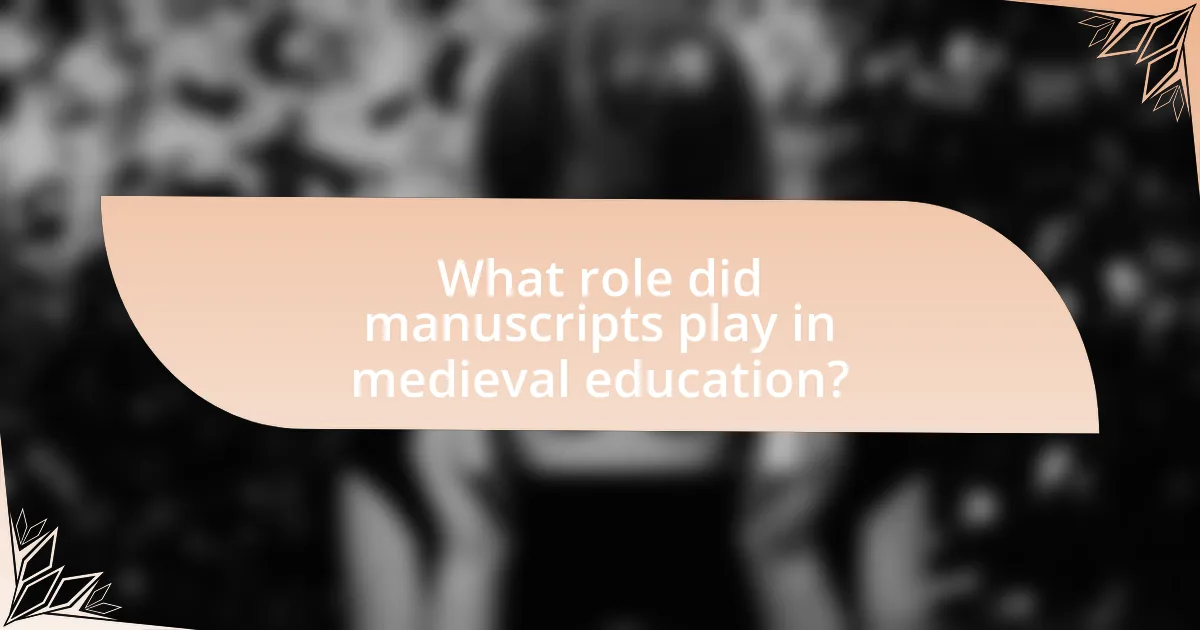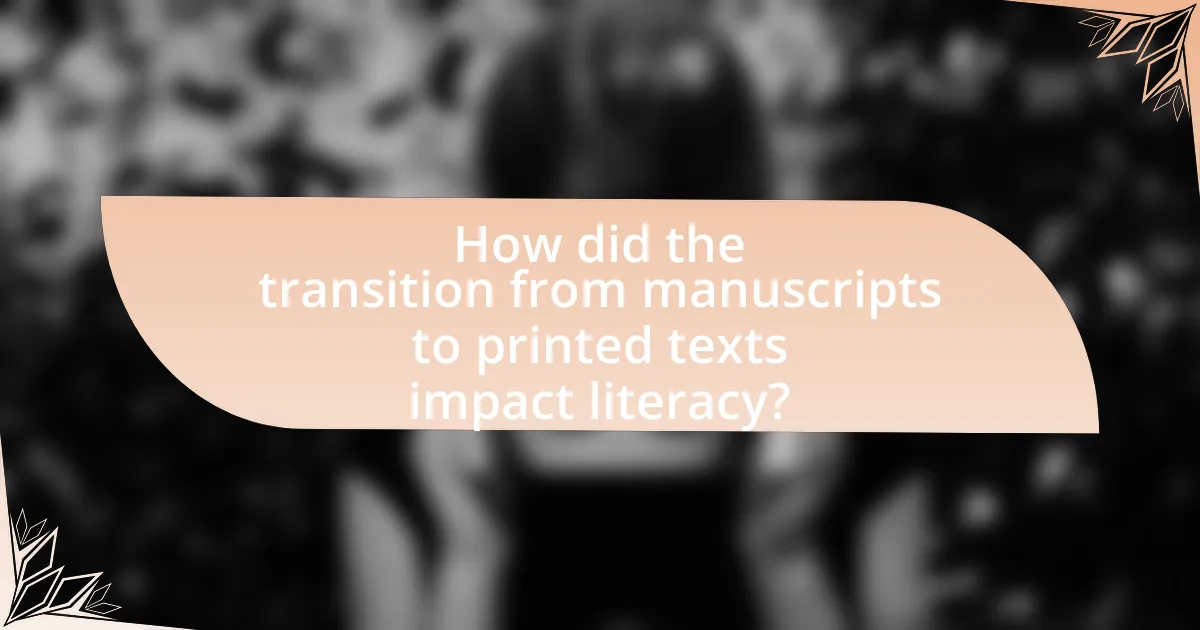The article examines the pivotal role of manuscripts in medieval education and their impact on literacy rates. It highlights how manuscripts served as primary educational resources in monastic and cathedral schools, facilitating the transmission of religious, philosophical, and scientific texts. The study details the types of manuscripts commonly used, their influence on teaching methods, and the correlation between manuscript availability and literacy development across different social classes and regions. Additionally, it explores the transition from manuscripts to printed texts and its implications for educational practices and literacy in society.

What role did manuscripts play in medieval education?
Manuscripts were essential in medieval education as they served as primary sources of knowledge and learning materials. They facilitated the transmission of texts, including religious, philosophical, and scientific works, which were crucial for the curriculum in monastic and cathedral schools. The production of manuscripts, often by scribes in scriptoria, ensured that educational institutions had access to a variety of texts, thereby promoting literacy and scholarly activity. Historical evidence shows that the availability of manuscripts directly correlated with increased literacy rates during the medieval period, as more individuals gained access to written knowledge, which was previously limited to oral traditions.
How were manuscripts utilized in educational institutions during the medieval period?
Manuscripts were essential tools in educational institutions during the medieval period, serving as primary sources of knowledge and learning materials. These handwritten texts, often produced by scribes in monasteries and scriptoria, contained religious, philosophical, and scientific works that formed the curriculum of medieval education. For instance, the study of texts such as the Bible, Aristotle’s works, and various commentaries was central to the education of clergy and scholars. The availability of manuscripts allowed for the dissemination of knowledge, contributing to the rise of universities in the 12th century, where students engaged with these texts to gain literacy and critical thinking skills. The establishment of institutions like the University of Bologna and the University of Paris further exemplifies how manuscripts facilitated structured learning and academic discourse during this period.
What types of manuscripts were most commonly used in medieval education?
The types of manuscripts most commonly used in medieval education included religious texts, classical works, and instructional manuals. Religious texts, such as the Bible and liturgical books, were central to education as they formed the basis of moral and spiritual instruction. Classical works, particularly those by authors like Aristotle and Cicero, were studied for their philosophical and rhetorical content, fostering critical thinking and eloquence. Instructional manuals, including grammar texts and treatises on logic, provided practical guidance for students in developing their language and reasoning skills. These manuscripts were essential in shaping the curriculum of medieval schools and universities, reflecting the educational priorities of the time.
How did the availability of manuscripts influence teaching methods?
The availability of manuscripts significantly influenced teaching methods by providing accessible texts that facilitated structured learning. With the rise of manuscript production in the medieval period, educators could utilize written materials to standardize curricula, allowing for a more systematic approach to teaching. This shift enabled the incorporation of diverse subjects, such as theology, philosophy, and grammar, into educational frameworks, enhancing the depth and breadth of instruction. Historical evidence shows that the proliferation of manuscripts, particularly in monastic schools, led to increased literacy rates among students, as they could engage directly with texts rather than relying solely on oral traditions. This transition marked a pivotal change in educational practices, emphasizing the importance of written knowledge in shaping teaching methodologies.
Why were manuscripts important for literacy development in medieval society?
Manuscripts were crucial for literacy development in medieval society because they served as primary educational resources that facilitated the dissemination of knowledge. The production of manuscripts, often by monastic scribes, allowed for the preservation and transmission of texts, including religious, philosophical, and scientific works. This accessibility to written material contributed to increased literacy rates among clergy and, eventually, laypeople. Historical evidence indicates that the establishment of scriptoria in monasteries during the Carolingian Renaissance significantly boosted literacy, as these centers produced standardized texts that were used for teaching. Consequently, the availability of manuscripts directly correlated with the growth of literacy and learning in medieval Europe.
What impact did manuscript literacy have on social mobility?
Manuscript literacy significantly enhanced social mobility by providing individuals with access to education and information that were previously restricted to the elite. This increased literacy allowed lower social classes to acquire knowledge, engage in trade, and participate in civic life, thereby facilitating upward mobility. Historical evidence shows that during the medieval period, regions with higher literacy rates, such as those influenced by monastic schools, experienced greater economic development and social change, as literate individuals could secure better jobs and positions within society.
How did the production of manuscripts affect literacy rates among different classes?
The production of manuscripts significantly increased literacy rates among the upper classes while maintaining lower rates among the lower classes. Manuscripts, primarily produced by scribes in monasteries and later in universities, were expensive and time-consuming to create, making them accessible mainly to the wealthy elite who could afford them. For instance, during the 12th century, the rise of universities led to a greater demand for texts, which resulted in more manuscripts being produced, but these were still predominantly owned by nobles and clergy. In contrast, the lower classes had limited access to these texts, resulting in a persistent literacy gap. Historical evidence shows that by the late Middle Ages, literacy rates among the clergy and nobility reached approximately 90%, while rates among peasants remained below 10%. This disparity illustrates how manuscript production reinforced existing social hierarchies in literacy.

What factors influenced literacy rates in medieval times?
Literacy rates in medieval times were primarily influenced by social class, access to education, and the availability of manuscripts. The nobility and clergy had greater access to educational resources, leading to higher literacy rates among these groups. In contrast, the peasantry often lacked formal education, resulting in lower literacy levels. Additionally, the proliferation of manuscripts, particularly after the invention of the printing press in the late medieval period, made written materials more accessible, further impacting literacy. Historical records indicate that by the 15th century, literacy rates in urban areas could reach up to 30%, while rural areas remained significantly lower, illustrating the disparity in educational access.
How did access to manuscripts vary across different regions?
Access to manuscripts varied significantly across different regions during the medieval period, influenced by factors such as geography, political stability, and cultural priorities. In regions like Western Europe, particularly in monasteries and cathedral schools, access was relatively high due to the establishment of scriptoria where manuscripts were copied and preserved. Conversely, in Eastern Europe and parts of the Islamic world, access was often limited by fewer educational institutions and less emphasis on manuscript production, leading to lower literacy rates. For instance, the Carolingian Renaissance in the 8th and 9th centuries promoted manuscript accessibility in Frankish territories, while the Byzantine Empire maintained a more centralized control over texts, impacting distribution. These regional disparities highlight how local conditions shaped the availability and use of manuscripts in education.
What role did monasteries play in the dissemination of manuscripts?
Monasteries played a crucial role in the dissemination of manuscripts during the medieval period by serving as centers of learning and preservation. Monastic communities were dedicated to copying, illuminating, and maintaining texts, which facilitated the spread of knowledge across Europe. For instance, the Benedictine Rule emphasized the importance of reading and writing, leading to the establishment of scriptoria where monks meticulously copied religious and classical works. This practice not only preserved ancient texts but also made them accessible to a wider audience, contributing to the rise of literacy rates in medieval society. Historical evidence shows that by the 12th century, monasteries had produced thousands of manuscripts, significantly impacting education and scholarship during that era.
How did political and economic conditions affect manuscript availability?
Political and economic conditions significantly influenced manuscript availability by determining the resources allocated for their production and preservation. During periods of political stability and economic prosperity, such as the Carolingian Renaissance, monasteries and educational institutions received ample funding, leading to increased manuscript production and accessibility. Conversely, during times of war or economic decline, resources were diverted away from manuscript creation, resulting in fewer texts being copied or maintained. For instance, the fall of the Western Roman Empire led to a decline in literacy and manuscript availability due to the instability and loss of patronage for scribes and scholars.
What were the demographic trends in literacy during the medieval period?
During the medieval period, literacy rates were predominantly low, with significant variation based on geography, social class, and gender. The clergy and nobility had higher literacy rates, often exceeding 90%, due to access to education and manuscripts, while the general peasant population had rates as low as 10%. Evidence from historical records indicates that urban areas exhibited higher literacy levels compared to rural regions, as cities provided more educational opportunities and resources. Additionally, the rise of universities in the late medieval period contributed to an increase in literacy among the educated elite, further widening the gap between different demographic groups.
How did gender influence literacy rates in medieval society?
Gender significantly influenced literacy rates in medieval society, with men generally having higher literacy levels than women. This disparity arose from societal norms that prioritized male education, as men were more likely to receive formal schooling and access to educational resources. For instance, records indicate that in the 12th century, only about 5% of women were literate compared to 30% of men, reflecting the limited opportunities for women to engage in learning. Additionally, the roles assigned to women often confined them to domestic responsibilities, further restricting their access to education and written materials. This gender-based divide in literacy was reinforced by the patriarchal structure of medieval society, which viewed education as a privilege primarily for males.
What age groups were most likely to be literate in the medieval era?
In the medieval era, young males aged 7 to 14 were the most likely to be literate. This age group typically attended monastic or cathedral schools where they received education focused on reading and writing Latin, which was essential for religious and administrative purposes. Evidence from historical records indicates that literacy rates were significantly higher among boys in this age range due to the structured educational systems established by the Church, which prioritized the training of clergy and educated elites.

How did the transition from manuscripts to printed texts impact literacy?
The transition from manuscripts to printed texts significantly increased literacy rates. The advent of the printing press in the 15th century allowed for the mass production of books, making them more accessible and affordable compared to hand-copied manuscripts. This accessibility led to a wider distribution of knowledge and educational materials, which in turn encouraged more individuals to learn to read and write. Historical data indicates that literacy rates in Europe rose dramatically during the 16th century, with estimates suggesting that literacy among the male population increased from about 30% to over 50% in some regions due to the availability of printed texts.
What changes occurred in educational practices with the advent of the printing press?
The advent of the printing press significantly transformed educational practices by making books more accessible and affordable. Prior to its invention, manuscripts were laboriously copied by hand, resulting in limited availability and high costs, which restricted education primarily to the wealthy and religious institutions. The printing press, invented by Johannes Gutenberg in the mid-15th century, enabled the mass production of texts, leading to a dramatic increase in the number of books available. This accessibility fostered a rise in literacy rates among the general population, as more individuals could obtain educational materials. Historical evidence indicates that by the end of the 16th century, literacy rates in Europe had increased substantially, with estimates suggesting that they rose from around 10% to over 50% in some regions, illustrating the profound impact of the printing press on education.
How did the printing press democratize access to literature and education?
The printing press democratized access to literature and education by significantly lowering the cost of book production and increasing the availability of written materials. Prior to its invention in the 15th century, books were laboriously copied by hand, making them expensive and accessible only to the wealthy or institutions. The introduction of movable type by Johannes Gutenberg allowed for the mass production of books, which led to a dramatic reduction in prices. For example, the price of a printed Bible dropped from several hundred guilders to about 1 guilder, making it affordable for a broader segment of the population. This increased availability of literature facilitated higher literacy rates, as more people had access to educational texts, religious materials, and literature, fostering a culture of reading and learning that was previously unattainable for the lower classes.
What were the implications of printed texts on manuscript culture?
Printed texts significantly diminished the prominence of manuscript culture by facilitating mass production and wider dissemination of written works. The advent of the printing press in the 15th century allowed for texts to be produced more quickly and at a lower cost than hand-copied manuscripts, which were labor-intensive and time-consuming. This shift led to a decline in the demand for manuscripts, as printed materials became more accessible to a broader audience, thereby increasing literacy rates. Historical evidence shows that the number of printed books rose dramatically, with estimates suggesting that by 1500, over 15 million copies of various texts had been produced, compared to the limited number of manuscripts available prior to this period. Consequently, the transition to printed texts not only transformed the landscape of literature but also altered educational practices, as institutions began to favor printed materials for teaching and learning, further marginalizing manuscript culture.
What lessons can be learned from the study of manuscripts and literacy rates?
The study of manuscripts and literacy rates reveals that access to written texts significantly influences educational attainment and literacy development. Historical analysis shows that regions with higher manuscript production, such as medieval monasteries, correlated with increased literacy rates among clergy and laypeople. For instance, the availability of Latin texts in monastic libraries facilitated learning and literacy, as evidenced by the rise of educated clerics during the Carolingian Renaissance. Furthermore, the examination of manuscript distribution patterns indicates that literacy was not uniformly spread; areas with fewer manuscripts often exhibited lower literacy levels, highlighting the importance of textual access in educational outcomes.
How can modern education systems benefit from understanding medieval manuscript use?
Modern education systems can benefit from understanding medieval manuscript use by gaining insights into historical literacy practices and pedagogical methods. Analyzing how manuscripts were utilized in medieval education reveals the importance of text accessibility and the role of collaborative learning, which can inform contemporary teaching strategies. For instance, the use of illuminated manuscripts in classrooms fostered engagement and visual learning, a principle that modern educators can apply through multimedia resources. Additionally, research indicates that literacy rates during the medieval period were closely tied to manuscript production and distribution, highlighting the significance of resource availability in education. Understanding these historical contexts can help modern systems enhance literacy initiatives and develop more effective educational frameworks.
What best practices can be derived from the historical context of manuscripts in education?
Best practices derived from the historical context of manuscripts in education include the promotion of collaborative learning and the integration of diverse texts to enhance literacy. Manuscripts in medieval education often involved communal reading and discussion, fostering a collaborative environment that improved comprehension and retention. Additionally, the use of various manuscript types, such as religious texts, legal documents, and scientific treatises, provided a rich tapestry of knowledge that catered to different learning styles and interests, thereby increasing engagement and literacy rates among students. Historical evidence shows that institutions like monasteries utilized these practices effectively, leading to higher literacy levels during the medieval period.